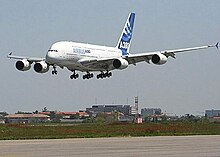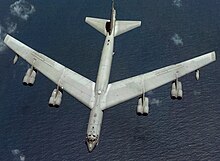Long-haul aircraft






A long-haul aircraft is an aircraft that can be used most economically for non-stop flights from around 5,000 km (from a range of 15,000 km one speaks of ultra- long-haul aircraft ).
Even today, long-haul machines are sometimes designed with four beams in order to be able to proceed freely with the route design. However, the trend is turning towards twin-engine machines, since modern aircraft with only two engines are also allowed to fly longer distances without airports in the vicinity of the flight route ( ETOPS rules).
Since passengers spend up to 19 hours on board, long-haul aircraft are often equipped with very extensive entertainment options, such as television in the seat or in the aisles, MP3 players in the seats, etc. in comparison to short and medium-haul aircraft. The offer varies considerably depending on the airline , class of transport or aircraft.
history
Long-haul aircraft from the era of propeller drives were less characterized by the fact that a distance of over 5000 km was economical than that it was possible at all. Only the last generation, in particular the Lockheed Super Constellation and the Douglas DC-7 , was able to cross the Atlantic non-stop, at least in the case that was not yet taken for granted at the time, that all four engines were running without problems and there was not too much headwind.
Even in the early jet age in the 1960s, routes of this length were reserved for four-engine aircraft, such as the Boeing 707 and later the B747, as the engines were still relatively unreliable. Later, three-jet aircraft were introduced with aircraft such as the Douglas DC-10 and MD-11 , as the engines became more reliable, maintenance costs were reduced by saving one engine, and the so-called economies of scale allowed larger engines to be operated more economically than smaller ones.
At the beginning of the 1980s, the Boeing 767 was the first twin-engine aircraft with a range of more than 10,000 km to hit the market. Various twin-engine Airbus models (A310, A300-600, A330) are also long-haul aircraft. After initial hesitation, these aircraft can now also be used on transatlantic and even transpacific routes. With the Boeing 777-200LR, a twin-engine aircraft even holds the range record today.
Only three four-engine long-haul aircraft are now available in civil aviation: the double-decker Boeing 747-8 and Airbus A380 , and the technically completely outdated Ilyushin Il-96 . Current three-engine models are the business jets Dassault Falcon 900 , Falcon 7X and Falcon 8X ; all other long-haul aircraft are twin- engine : Boeing 737-700ER , 767, 777 and 787 , Airbus A319LR , A330 and A350 and some business jets .
Reference routes
Typical reference routes for long-haul aircraft are the connection from Europe to the west coast of the USA (e.g. Frankfurt - Los Angeles ) and transpacific routes (e.g. Tokyo - Los Angeles).
The currently longest flight routes by time include:
- Singapore - New York / Newark (approx. 18-19 h; approx. 16,700 kilometers; Singapore Airlines )
- Auckland - Doha (17 h 30 min; 14,300 kilometers; Qatar Airways )
- Auckland - Dubai (17 h 25 min; 14,200 kilometers; Emirates )
- San Francisco - Singapore (17 h 25 min; 13,600 kilometers; Singapore Airlines , United )
- Dallas - Sydney (17 h 00 min; 13,800 kilometers; Qantas )
- Perth - London (<17 h 00 min; 14,500 kilometers; Qantas )
- Johannesburg - Atlanta (16 h 58 min; 13,600 kilometers; Delta )
- Dubai - Houston (16 h 35 min; 13,100 kilometers; Emirates )
- Dubai - Los Angeles (16 h 20 min; 13,400 kilometers; Emirates )
- San Francisco - New Delhi (16 h 15 min; 15,500 kilometers; Air India )
- Dubai - San Francisco (16 h 15 min; 13,000 kilometers; Emirates )
- New York City - Hong Kong (16 h 10 min; 13,000 kilometers; United , Cathay Pacific )
- Dubai - Dallas (16 h 00 min; 12,900 kilometers, Emirates )
- New York City - Guangzhou (15 h 50 min; 12,900 kilometers; China Southern )
- Johannesburg - New York City (15 h 40 min; 12,800 kilometers; South African Airways )
- Vancouver - Sydney (15 h 25 min; 13,800 kilometers; Air Canada )
The longest flight routes by time from airlines in German-speaking countries:
- Frankfurt - Buenos Aires (13 h 50 min; 11,500 kilometers; Lufthansa )
- Singapore - Zurich (13 h 00 min; 10,300 kilometers; SWISS )
- Hong Kong - Vienna (12 h 30 min; 8,700 kilometers; Austrian )
Ultra long-haul aircraft
Aircraft that have a range of more than 15,000 km are referred to as ultra-long-haul aircraft.
The four-engine Airbus A340 -500 has a range of 16,000 km, the twin- engine Boeing B777 -200LR of almost 17,500 km. The Airbus A350 has a range of over 15,000 km in several versions, with the A350-900ULR the new record should be 17,600 km. The A340-200 variant still holds the route record for four-engine passenger aircraft, set up on a test flight from Paris to Auckland with more than 19,000 km in 1994.
The mathematically meaningful maximum range is 20,000 km, because then every point on earth can be reached without a stopover. So far, however, there are very few routes that require ultra-long-haul aircraft, especially from the USA to Asian or Arab countries such as Singapore - Los Angeles , Singapore- New York and Dubai- New York.
However, over a distance of around 15,000 km, ultra-long-haul flights are becoming increasingly uneconomical due to the high fuel consumption. The reason for this is that a lot of it is already used to transport the high amount of fuel itself and the possible payload is also lower. As a rule of thumb, B. for the Boeing 747-400 an additional consumption of 4% per hour. For a flight of twelve and a half hours, this means that at the destination of the original 10 tons of reserve fuel, only 5 tons are left. For this reason, Singapore Airlines , for example, has now withdrawn from ultra-long-haul routes. The routes from Singapore to Newark (approx. 16,000 km, a good 18 hours) and Los Angeles (approx. 14,000 km) were discontinued in autumn 2013, but returned to the flight plan in autumn 2018 after the Airbus A350-900ULR went into service.
According to calculations by the non-profit organization atmosfair , airplanes use around 10% more kerosene on a 15,000-kilometer non-stop flight than on a flight on a similar route with a refueling stop.
Airplane types on long-haul flights
Multi-jet aircraft are used more and more:
- four-engine aircraft that are not restricted by the ETOPS regulations,
- three-engine aircraft (trijets), in which two of the engines are attached to the wings or on the rear fuselage and the third engine is mounted below the rudder, and
- twin-engine aircraft (twinjets) that dominate air traffic today.
Six -engine aircraft , such as the American Boeing B-47 Stratojet or the custom-made Soviet (today: Ukrainian ) Antonov An-225 Mrija , were also designed primarily for military use . The American Boeing B-52 Stratofortress bomber is the only series - produced eight- engine aircraft that is still in use today.
Passenger planes
The table lists some passenger planes that were or are usually used on long-haul routes.
| Aircraft type | Design country |
|---|---|
| Airbus A310 | Europe |
| Airbus A330 | Europe |
| Airbus A340 | Europe |
| Airbus A350 | Europe |
| Airbus A380 | Europe |
| Boeing 707 | United States |
| Boeing 747 | United States |
| Boeing 767 | United States |
| Boeing 777 | United States |
| Boeing 787 | United States |
| Concorde * | Europe |
| Convair CV-990 | United States |
| Douglas DC-6 | United States |
| Douglas DC-7 | United States |
| Douglas DC-8 | United States |
| Ilyushin Il-62 | Soviet Union |
| Ilyushin Il-86 | Soviet Union |
| Ilyushin Il-96 | Soviet Union |
| Lockheed Super Constellation | United States |
| Lockheed Starliner | United States |
| Lockheed L-1011 TriStar | United States |
| McDonnell Douglas DC-10 | United States |
| McDonnell Douglas MD-11 | United States |
| Tupolev Tu-114 | Soviet Union |
| Tupolev Tu-116 | Soviet Union |
| Tupolev Tu-144 * | Soviet Union |
| Vickers VC10 | Great Britain |
* = Supersonic aircraft with limited range
See also
Individual evidence
- ↑ a b Longest non-stop flight in the world takes off. Spiegel online, October 11, 2018, accessed October 20, 2018.
- ↑ a b Singapore Airlines Launches World's Longest Flight. Singapore Airlines press release, October 12, 2018, accessed October 20, 2018.
- ^ Daniel Tautz: Qantas Airways. First direct flight from Australia to Europe. In zeit.de. Die Zeit , March 25, 2018, accessed on March 26, 2018.
- ↑ Dow Jones & Co, Inc: SIA to increase flights to Australia, Japan. In: Theedgesingapore.com. December 18, 2012, archived from the original on September 26, 2013 ; accessed on March 26, 2018 .
- ↑ Singapore Airlines discontinues longest passenger flight in the world. In: spiegel.de. Der Spiegel , accessed November 25, 2013.
- ↑ Holger Dambeck: Ultra long-haul flights: Non-stop around the world - at the expense of the climate. In: Spiegel online. January 30, 2019, accessed May 30, 2019 .


